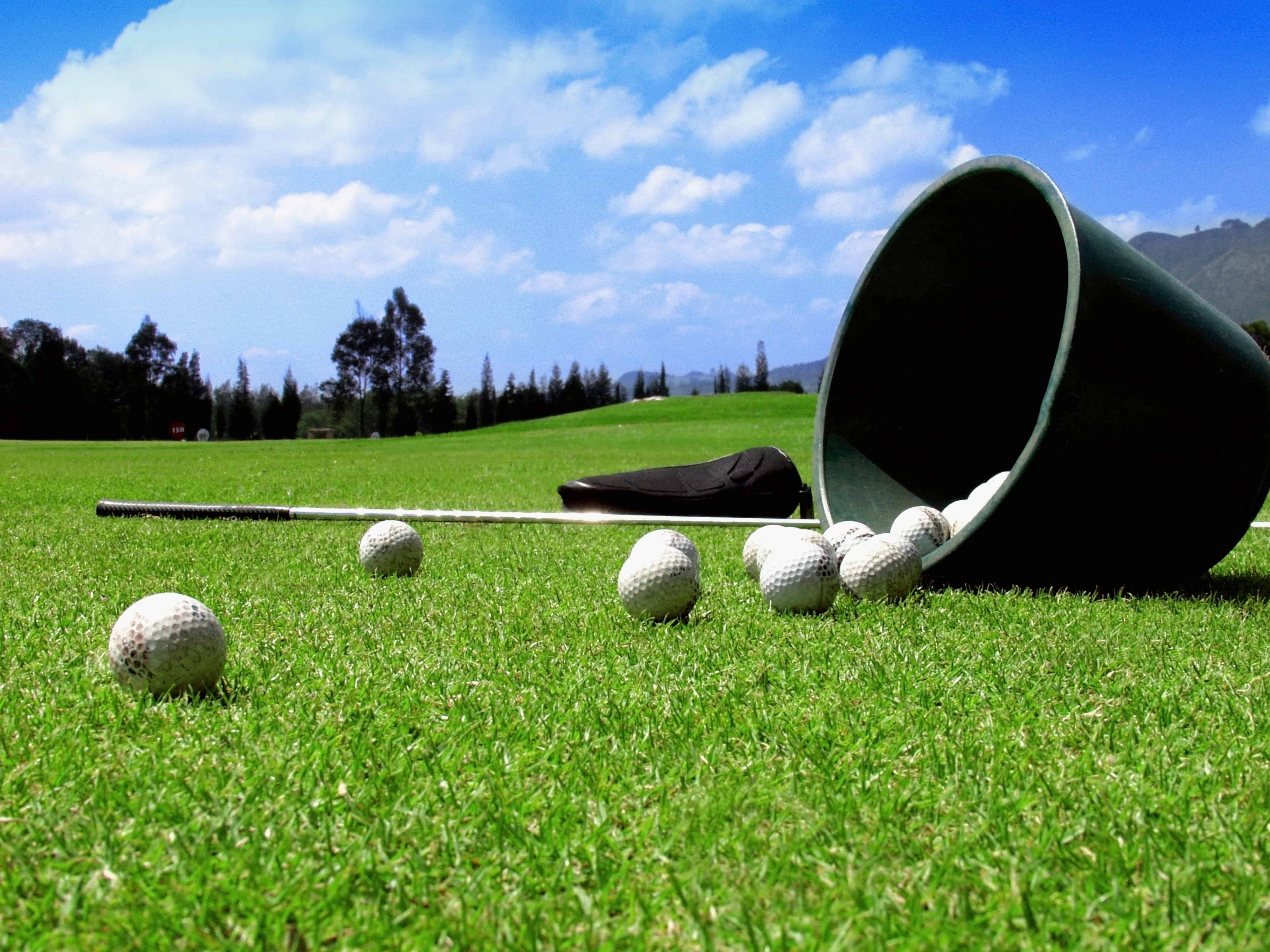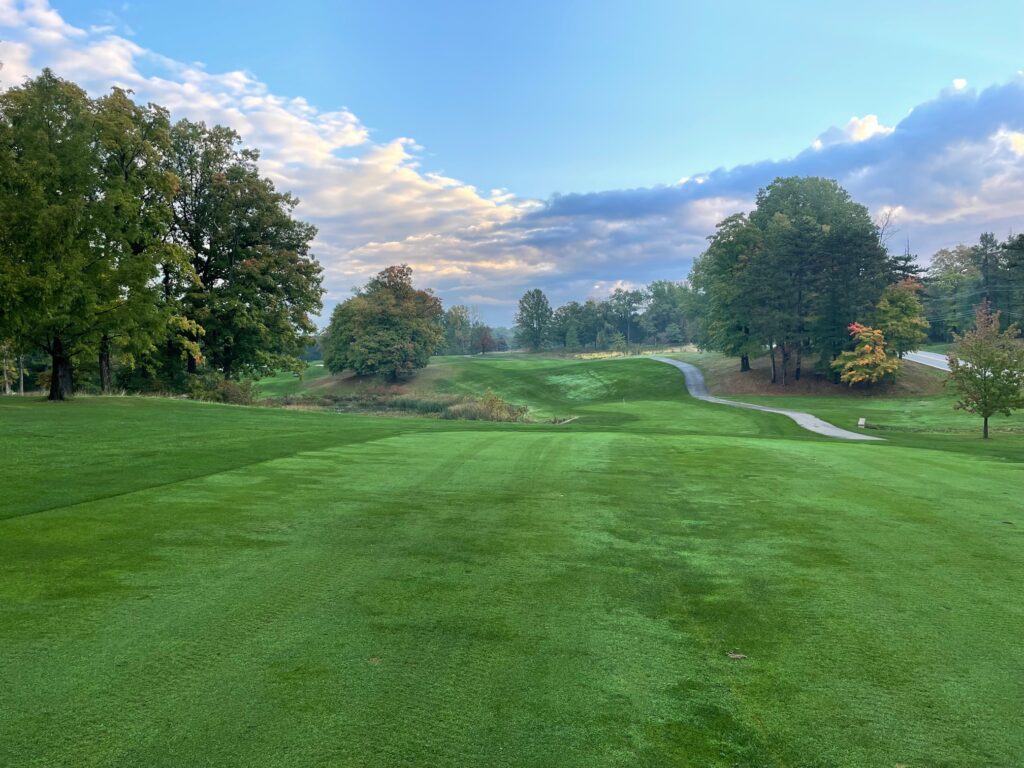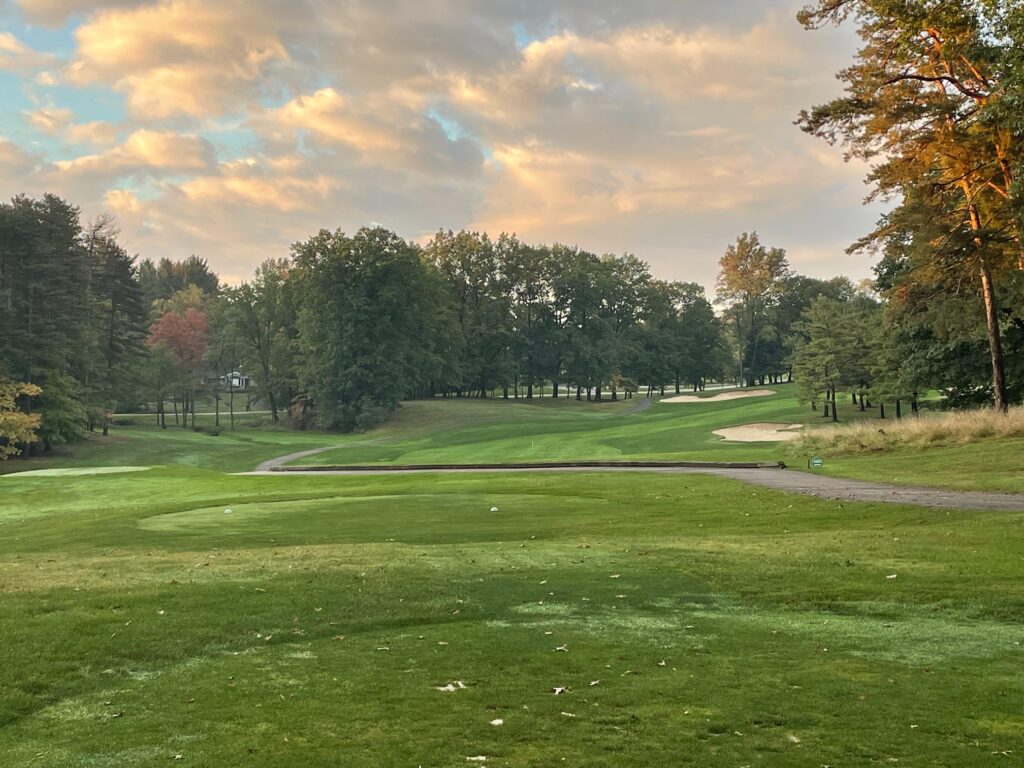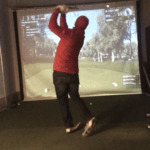There are a wide range of swing faults and fixes that we will dive into. They include the following:
- Fault: Poor Contact, Fix: Low Point Control Drill
- Fault: Slice, Fix: Shoulders Closed Drill
- Fault: Hook, Fix: Freezer Drill
- Fault: Start Line Issues, Fix: Stock Shot Drill
- Fault: Distance Control, Fix: Map Your Bag Process
- Fault: Lack of Distance, Fix: Speed Training Protocols
- Fault: Lack of Knowledge, Fix: Study The Ball Fight Laws
Let’s face it, we all have issues with our golf swing at times.
Even the best golfers can win a tournament one week and miss the cut the next week.
So what do you do when your swing goes bad? You should have your list of faults and fixes to quickly get your swing back on track.
The more a golfer owns their swing, the quicker they can get back on track. Figuring out what your issues are and now to fix them is a key to consistently and playing your best golf.
I know what my swing faults are: my body can stall at times and I tend to hit a hook or I get quick in transition. I know what drills I can turn to in order to get my golf swing back on track.
Below, I will offer some drills for some of the common issues with golf swings.
For some inspiration on owning your golf swing, let’s turn to a quote by Arnold Palmer.
Swing your swing. Not some idea of a swing. Not a swing you saw on TV. Not that swing you wish you had. No, swing your swing. Capable of greatness. Prized only by you. Perfect in its imperfection. Swing your swing. I know, I did.
Arnold Palmer
Golf Swing Fixes (Top 7 Below)
Update: The basics of golf come down to 3 keys. Hitting the ball solid (controlling the low point), hitting the ball with a consistent start line and curve (stock shot drill) and hitting the ball far enough (train for speed). These can continue to be the measuring sticks for golfers on their journey to game improvement!
We believe in the three fundamentals or keys in the game of golf. The golfer must be able to do the following:
- Control the low point of the swing to ensure consistent ball striking.
- Control the start line and curve of the ball to have a predictable shot pattern.
- Have enough speed to play the course.
Of course, the short game is vital to the overall success, but we start with the full swing.

Fix #1: Low Point Control Drill
The low point control drill is excellent for any and all golfers to practice. Whether you are having low point control issues or are new to the game, we all must be able to strike the ball solid. If you are hitting the ball fat or thin, turn to the low point control drill and work on it for several weeks. The good news is that you can complete this drill at home with wiffle balls in your backyard.
The Drill: The Low Point Control Dril
- Take some yard paint and paint a 1-2 yard long line.
- Setup with 55% of your weight on your front side.
- Try to hit the target side of the line and see how many times out of 10 you can do this successfully!
- Repeat this drill every day for a month, tracking your progress and your ability to to this successfully in trials of ten.
- You may need to start with half swing and progress to full swings.
If you are struggling, put more weight forward and work on keeping your head still to help control the low point in the swing.
How to improve your ball striking skills in golf
Fix #2: Shoulders Closed Drill
Many golfers struggle with the slice. The major issue is that the shoulders often fly open at the start of the downswing, resulting in the hands moving out and the swing path being too extreme from out to in. The path is well left the face is often open, resulting in a major slice.
If you are struggling with the slice, check out this drill below.
The Drill: Shoulders Closed Drill
This drill is rather simple. It all starts with the proper setup. The golfer should follow the steps below.
- Set up square to the ball.
- Go ahead and close your shoulders so that your front shoulder is closer to the ball than your back shoulder.
- Take a normal grip and ensure the club face is aimed toward the target.
- Go ahead and keep your shoulders quiet and swing along your shoulder line.
By setting up like this the golf swing is forced to swing along a closed shoulder line. The goal here is to help you get the feel of more closed shoulders because oftentimes the over the top movement happens when the golfer fires the upper body and the hands move out and across the ball resulting in a poor swing path.
Go ahead and hit 20-50 shots until you can get the ball to start turning right to left for the right handed golfer. If you are struggling, try to keep everything still other than your arms.
Fix #3: Freezer Drill
This is an excellent drill for the golfer that is fighting the hook. The hook usually is a result from the body out racing the arms and the hands. The body gets too far ahead and then stalls as the hands try to catch up and flip through the shot.
The golfer will either hit a big push or a hook when the hands become overactive. The goal is to synch the arms and body closer to each to get the timing right and everything more square at impact.
The Drill: Freezer Drill
- Set up to the shot.
- Swing to the top of your backswing and stop.
- Hold for 3 seconds.
- Go ahead and hit the ball.
Hit 10 of these shots and then 5 regular shots. Alternate back and forth and work on feeling the right timing.

Fix #4: Stock Shot Drill
Maybe our favorite drill of all time. This drill is great to help control the start line and what direction your ball is curving. Whether you hit a stock draw or a stock fade, you need a go to shot that you can count on in the most pressure packed situations.
The golfer that has a reliable stock shot can plot his or her way around the course and put them in a position to attack certain pins. There is no better feeling than stepping up to your shot and have a very good idea of the start line and what way the ball will curve.
The best golfers can do this. The highest handicap golfers have no idea where the ball is starting or what direction it is going to curve.
The Drill: Stock Shot Drill
- At the driving range, set up an alignment stick about 6-8 yards in front of you, straight down your target line.
- If you have a second alignment stick, set the stick 3-4 feet right of the first stick (for a draw) or left of the first stick (for a fade).
- Complete your initial assessment see how many times out of 10 you can start the ball to the right or left of your target. Pick one side and measure your game at this point.
- The goal is to eventually get 7 out of 10 shots to start to the correct side and draw back towards the target.
Fix #5: Map Your Bag Process
For the golfer that hits a 7 iron 150 one time and 165 the next time, it is time to get an official distance on every club in your bag and actually create a chart that maps the distance for every club in your bag.
I would highly recommend each golfer create a distance chart like the sample below:
| Club | Carry Distance (100%) | 90% | 80% |
| 2 Utility Iron | 210 | ||
| 4 iron | 190 | ||
| 5 iron | 181 | ||
| 6 iron | 171 | ||
| 7 iron | 163 | ||
| 8 iron | 153 | ||
| 9 iron | 143 | ||
| P Club | 130 | 123 | 115 |
| Pitching Wedge | 118 | 110 | 102 |
| SW Club | 105 | 97 | 91 |
| LW Club | 90 | 82 | 74 |
How can you create your own chart?
I would highly recommend a Skytrak or Mevo that you own and can use on a regular basis.
These portable devices can be used at the driving range, golf course or set up in your home net or golf simulator. These devices are game changers not only on being able to map your bag and know your distances, but they also provide quality feedback after on every shot and provide the following information:
- Carry Distance
- Spin Rate
- Launch Angle
- Spin Axis
- Total Distance
- Ball Speed
This information will help you map your bag, decide on which clubs are best for your game, develop a stock shot and much more. I love using my SkyTrak 365 days a year in my golf simulator setup.
The Drill: Map Your Bag Process
The process for mapping your bag can looking something like this:
- Hit 5 shots with each club in your bag.
- Log the carry distance and total distance for each shot.
- Eliminate any outlier numbers (poor hits or low spin rates).
- Take the average and create a map of your bag.
If you visit any PGA Tour event you will see plenty of golfers utilizing their launch monitors. While most can’t afford a Trackman, there are some very affordable options in the 500-2000 dollar range. I own the SkyTrak and think the world of it.
Here are the top 3 options to check out:
Fix #6: Speed Training Protocols
I spent many years wondering how I can increase my swing speed. When I was playing junior golf, we weren’t fortunate enough to have some of the training aids and knowledge that is now available. Smart people have studied the golf swing and have created training aids and protocols to help all golfers increase their distance!
At around the same time, the statistics from the PGA Tour have become more clear and the importance of speed is acknowledged by many to be a key to being the best on the PGA Tour.
Within the past several years, there have been several products hit the market to make speed gains possible. While many people for many years waited for the latest driver to come out to gain an additional 5-10 yards, you can now do this even with your current clubs.
I have no power in my golf swing! Help!
Did you know that with the SuperSpeed Training System you can gain 5-8% increase in swing speed as early as the first training session? This would allow you to gain somewhere between 10 and 30 yards depending on your current swing speed.
SuperSpeed Golf – Use Discount Code Golfjourney365 for some savings!
The SuperSpeed Training System is based on three different swing speed sticks all weighing at different weights. There is a green club that is 10% lighter than the average driver, the blue club which is 5% lighter and the red club which is actually 5% heavier!
Following their prescribed protocols the golfer completes the training every other day. The total time to complete most of their protocols is between 10-15 minutes. Most people can find the time to make this happen. The golfer will also need a swing radar to measure their progress.
The science behind the SuperSpeed Training System is based on overspeed training. Overspeed training has been around for several decades now and has been used by olympic athletics in the sport of Track and Field.
The science behind this overspeed training is based on the premise that your brain will only allow your body to move as fast as it feels it can stop safely! So, you get to work and swing the clubs as fast as possible, retraining your brain to allow you to swing your driver faster.
For more permanent results, the golfer should continue these training protocols for several months. The initial 5-8% is great and can become more permanent with the right length of training. The golfer can expect to continue to break down barriers every several months at a 1-2% increase.
My own experience has been an increase of 7-10 miles per hour on average from between 98-101 all the way up to 106-109. My goal is to hit the PGA Tour average of 113 mph in the coming months. I will continue to train every other day and watch in amazement as I am hitting drivers longer now than ever before!
Phil Mickelson (a senior golfer now) has been known to increase his swing speed in the past year or so and is close to 120 miles per hour in his swing speed. There are potential results for golfers of all ability levels and age!
Check the current price on SuperSpeed Golf System, here!
| Original Swing Speed | After 4-6 Weeks | New Carry Distance | Total Distance |
| 95 | 102 | 245 | 265 |
| 100 | 108 | 259 | 279 |
| 105 | 113 | 271 | 291 |
| 110 | 118 | 283 | 303 |
Fix #7: Study Ball Flight Laws
A key understanding that can help you grow your knowledge and the ability to understand your golf swing are the ball flight laws. Understanding the ball flight laws can help you figure out swing path and club face issues that you might be facing. The best drill to turn to above is the stock shot drill detailed above.
The basic idea of the ball flight laws is that the ball will start in the direction that the club face is pointing at impact. The clubface controls about 75% of where the ball will start.
From there it will curve based on the swing path relative to the club face. For example, if your club face is 2 degrees right and your path is 4 degrees right. The ball will start right and curve left towards the target, which is away from the swing path direction.
To develop a consistent shape in your shot pattern, you will attempt to build similar numbers with the majority of your golf swings.
Below, I will provide several examples that help you practice what way your ball will curve and get the general understanding of what is taking place. The goal is to eliminate the shot that starts and curves in a different direction then what you are intending to do.
This will help eliminate big numbers from your scorecard.
Having this information will help you make the adjustments mid round or post round and not get stuck in the rabbit hole of swing corrections.
I provide three examples below, all which include a club face that is right and a path that is right. You can see how a slight variation in the difference between the face and the path can cause a ball to curve.
Ball Flight Laws: Scenario 1
Clubface: 3 degrees right
Swing Path: 3 degree right
The ball will start right of the target line (club face is 3 degree open or right) and fly straight since the clubface and the swing path are the same number of degrees open or right of the target line.
The end result is a push shot. The ball will start right and stay right.
Ball Flight Laws: Scenario 2
Clubface: 3 degrees right
Swing Path: 5 degree right
The ball will start right of the target line (club face is 3 degree open or right) and curve away from the swing ptch, which means it will curve left.
The end result is a draw shot. The ball will curve a decent amount with these numbers.
This shot would be considered a push draw.
Ball Flight Laws: Scenario 3
Clubface: 3 degrees left
Swing Path: 10 degree left
The ball will start left of the target line (club face is 3 degree closed or open) and slice since there is a big gap between clubface and swing path. The end result is a pull slice. The ball will start left and curve hard to the right.
This is a shot that many amateurs struggle with. They continue to aim further and further left. The swing path keeps moving left and the face remains open. The end result is a full slice.
Additional Drills: 11 Drills for the Driving Range

My Secret To Golf Improvement
Let’s face it, in order to get really good at golf, we must practice frequently. About three years ago, I made the leap and invested in a golf simulator build for my garage. I went with a SkyTrak Launch Monitor and the TGC software and can now play over 100,000 courses including Augusta, Pebble Beach, Bethpage Black, Whistling Straits. St. Andrews and many other of the top 100 courses in the world.
This golf simulator setup, which is more affordable that you might imagine, has been a game changer. I can now play golf everyday of the year regardless of rain, snow, cold weather or time of day. I can practice or play rounds of golf. I can stand in the 11th fairway at Augusta and with the auto-rewind feature I am able to practice my approach shots from various differences.
It is worth checking out through Rain or Shine Golf as they offer some incredible packages along with financing offers that are difficult to beat.
Some direct links to Rain or Shine Golf for pricing and financing:
Take Action – What You Can Do Today to Get Better
What does this mean for you? I believe in the following recipe to get better:
1 – Improve your motion in the golf swing by identifying a golf instructor. Here are some options:
Here is a list of golf instructors that we have reviewed:
2 – Train to swing faster and improve your swing speed. Here are some options:
Looking to gain more Speed and Distance in your swing. Two Options:
3 – Understand course strategy and work to break through your next barrier. Here is a series on breaking through:
We have provided guides on how to break 100, 90, 80 and 70. Check out more below, if interested.
4 – Practice Frequently
Did you know that I build a golf simulator in my garage and have played over 500 rounds of golf on my SkyTrak system? It has been a game changer and one worth checking out. Here are some of my other posts on golf simulators frequently asked questions:
- Is a Golf Simulator Worth It?
- How to Build a Golf Simulator?
- What is the Best Golf Simulator?
- Golf Simulator Accessories?
- How to Build a Golf Simulator for under $7000
- Top 11 Reasons to Buy a SkyTrak
- How to Build a Golf Simulator for Under $1000
- Why Build A Golf Simulator?
- What Space is Needed?
- Can A Golf Simulator Improve My Game?
- How Much Does A Golf Simulator Cost?
- Don’t Forget to Check out our 15 best golf swings of all time.
I am an amateur golfer on a journey to get better, enjoy the game as often as possible and share my passion and knowledge with others. I have coached high school golfers at a high level and have a great passion for the game and want to give back. I enjoy learning about the golf swing and am currently studying to be a certified professional golf instructor. Join me in our journey to get better everyday.

